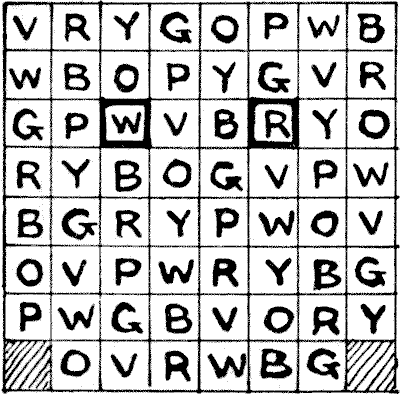The art of producing pictures or designs by means of joining together pieces of hard substances, either naturally or artificially colored, is of very great antiquity. It was certainly known at the time of the Pharaohs, and we find a reference in the Book of Esther to "a pavement of red, and blue, and white, and black marble." Some of this ancient work that has come down to us, especially some of the Roman mosaics, would seem to show clearly, even where design is not at first evident, that much thought was bestowed upon apparently disorderly arrangements. Where, for example, the work has been produced with a very limited number of colors, there is evidence of great ingenuity in preventing the same tints coming in close proximity. Lady readers who are familiar with the construction of patchwork quilts will know how desirable it is sometimes, when they are limited in the choice of material, to prevent pieces of the same stuff coming too near together. Now, this puzzle will apply equally to patchwork quilts or tesselated pavements.
It will be seen from the diagram how a square piece of flooring may be paved with sixty-two square tiles of the eight colours violet, red, yellow, green, orange, purple, white, and blue (indicated by the initial letters), so that no tile is in line with a similarly coloured tile, vertically, horizontally, or diagonally. Sixty-four such tiles could not possibly be placed under these conditions, but the two shaded squares happen to be occupied by iron ventilators.

The puzzle is this. These two ventilators have to be removed to the positions indicated by the darkly bordered tiles, and two tiles placed in those bottom corner squares. Can you readjust the thirty-two tiles so that no two of the same color shall still be in line?
Solutions: 1
This eBook is for the use of anyone anywhere in the United States and most other parts of the world at no cost and with almost no restrictions whatsoever. You may copy it, give it away or re-use it under the terms of the Project Gutenberg License included with this edition or online at http://www.gutenberg.org. If you are not located in the United States, you'll have to check the laws of the country where you are located before using this ebook.